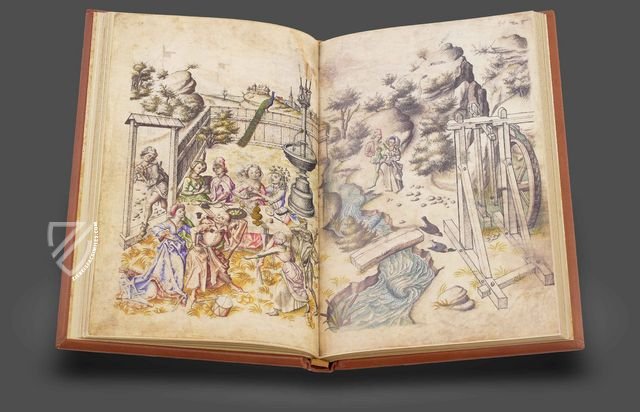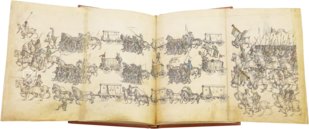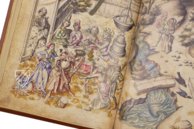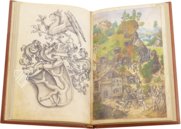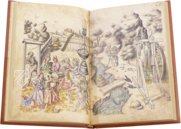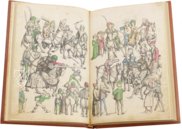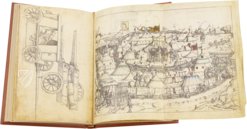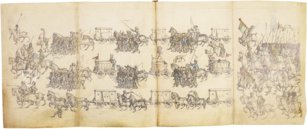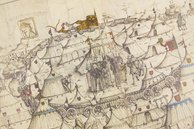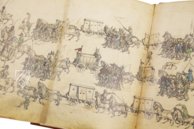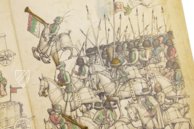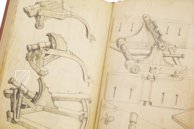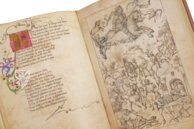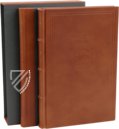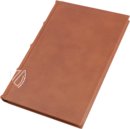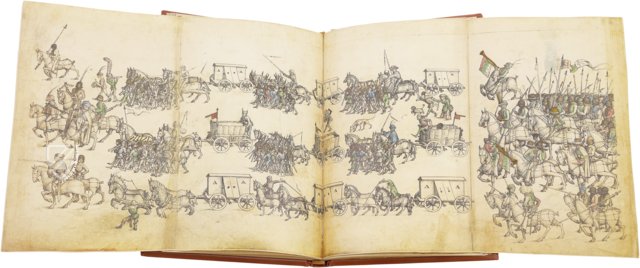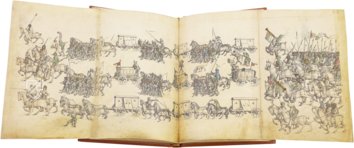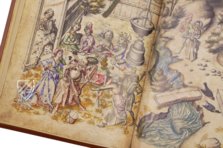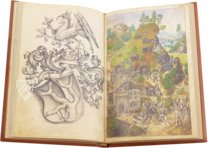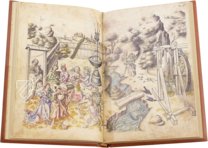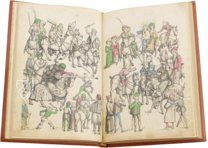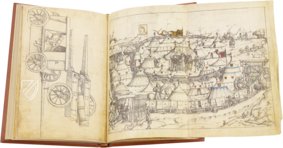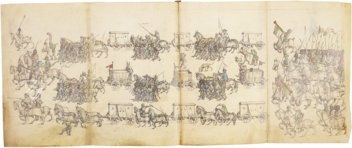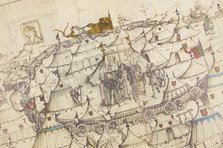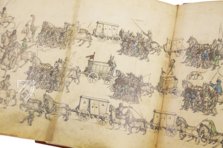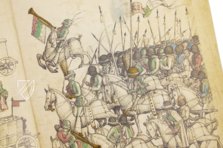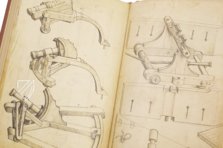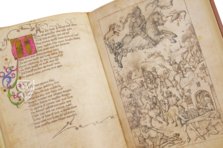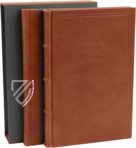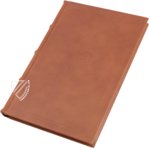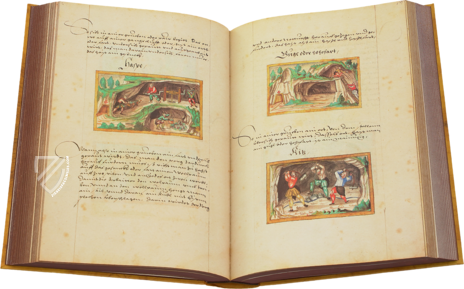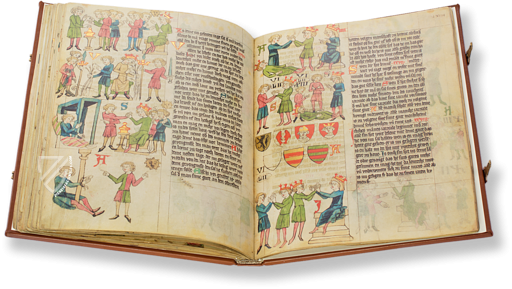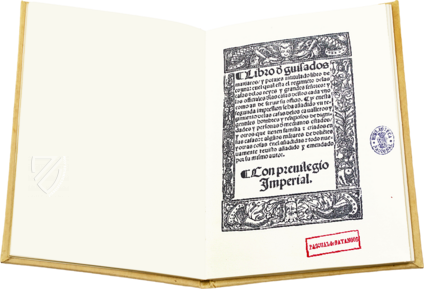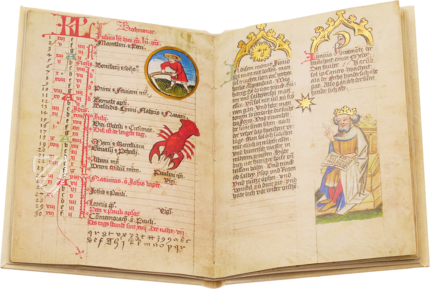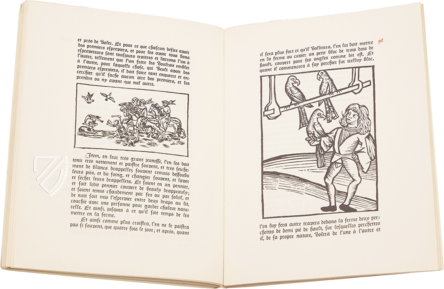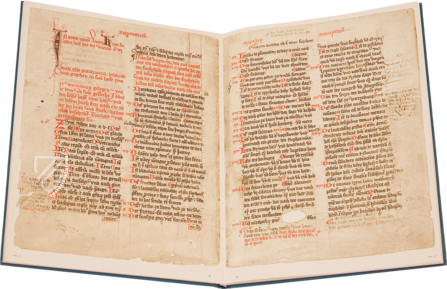Medieval Housebook of Wolfegg Castle
(1,000€ - 3,000€)
Created sometime between 1470 and 1480 by a team of authors, the so-called Housebook of Wolfegg Castle is a compendium designed for use in an aristocratic household, which is noteworthy for the lively, high-quality imagery that fills the pages. These 47 miniatures, vignettes, and marginalia are particularly useful for their insights into everyday life in the Late Middle Ages. Most of them consists of colored pen drawings, while others are uncolored but masterfully shaded. The text of the manuscript is divided into 6 sections: memorization techniques; astrological descriptions of the planets; illustrations of a bathhouse, a castle with moat, a tournament including the joust, hunting scenes, and an "obscene love garden"; recipes ranging from cooking to pharmacology to dying fabrics; mining, metallurgy, and assessing gold coins; weapons, siege equipment, and other military technology.
Medieval Housebook of Wolfegg Castle
The Medieval House Book of Wolfegg Castle contains practical knowledge useful for a nobleman and head of a family. It was completed ca. 1480 by a team of artists and scribes, probably in the Middle Rhine region. This splendid manuscript is as famous for the refinement of its miniatures as it is for the quality of the information it holds. They present a vivid depiction of everyday life in late medieval Germany, but the artist primarily responsible for them is known simply as the Master of the House Book. The artfully adorned manuscript is filled with practical knowledge for the running of an aristocratic household from accounting to defending one’s castle.
What is a Housebook?
Housebooks are collective manuscripts of occupational or professional content written by scholars since the late-15th century. Initially commissioned by the aristocratic upper class, in the 16th century they were also acquired by wealthy and educated members of the emerging middle class. These works collect three different types of texts: the so-called Hausväterliteratur or “Paterfamilias literature”, which deals primarily with the proper management – the so-called oikologia – of a household; the Artesliteratur or “technical literature” with descriptions of weaponry and warfare; and the Erbauungsliteratur or “edification literature”, the compilation of spiritual texts for domestic use. Additionally, housebooks contain the patron’s biographical information or deal with special events. Printed housebooks proliferated during the 16th century but lost their popularity by the end of the century with some existing works being preserved in private ownership, including the manuscript at hand. Since the second half of the 20th century, they have been appreciated by scholars as significant sources, both with regard to their content and those who commissioned them.
State of the Manuscript
63 of the manuscript’s original 98 parchment leaves survive to the present. Of them, 47 contain at least partially colored pen and ink drawings measuring 25 x 15 cm for single pages and 35 x 26 cm for double pages. Most of the contents are drawn from various Latin and German texts and the hands of at least three different draftsmen can be discerned along with various colorists. The illustrations include coats of arms, planetary and astrological imagery, aristocratic pastimes such as tournaments, hunting, bathing, and courtship, and diagrams of various tools used by craftsmen and miners as well as military equipment and tactics.
Evolution of the Work
The composition of the manuscript appears to have changed as work on it progressed. Early sections are more elaborate in their design and execution using a sophisticated script and being more richly illustrated. Later sections added by another scribe are written in a simpler bastarda and are more practical in nature. Some of the illustrations appear to be based on engravings by the Master E.S., an anonymous late-Gothic German artist. However, some scholars argue that the housebook was designed with a coherent program that was never fully realized.
The Mysterious Patron
Despite beginning with an elaborate full-page coat of arms, the patron of this splendid compendium remains unknown. This coat of arms has never been definitively assigned to any family although names such as Ast, Klotz, Stange, or Buchner have been hypothesized. Some recent research speculates that the work was commissioned by the Archbishop of Mainz, Berthold von Henneberg (1442–1504) as a gift to Maximilian I (1459–1519) when he was still Archbishop of Austria.
Ownership History
During the 17th century, the manuscript came into the possession of Maximilian Willibald von Waldburg-Wolfegg, who was one of the most important art collectors of his time. For the next three centuries, the housebook has been kept in Wolfegg Castle in Wolfegg, Upper Swabia, as part of a private collection that remains obscure to the public. In February of 2008, the House of Waldburg-Wolfegg-Waldsee sold the work to an unnamed domestic buyer who is believed to be August von Finck Junior and is rumored to have paid 20,000,000 €.
Codicology
- Alternative Titles
- Mittelalterliches Hausbuch von Schloss Wolfegg
Mittelalterliches Hausbuch - Size / Format
- 106 pages / 29.0 × 19.5 cm
- Origin
- Germany
- Date
- Ca. 1470–1480
- Epochs
- Style
- Illustrations
- 47 colored pen drawings
- Previous Owners
- Maximilian Willibald of Waldburg-Wolfegg
Medieval Housebook of Wolfegg Castle
The Love Garden
The love garden or pleasure garden was a popular motif in the courtly literature of the Late Middle Ages and here serves to complete the cycle of paintings on aristocratic life. In an enclosed garden with a decorative fountain, four chivalrous couples enjoy themselves indulging not only in food, drink, and music but above all in courtship. A bagpiper joins the scenery through the gate on the left. Things are much more sedate on the right side of the stream, which meanders through the picture in artfully draped waves. A knight of the Order of the Jug and an elegantly dressed lady stroll along the bank and observe the boisterous hustle and bustle.
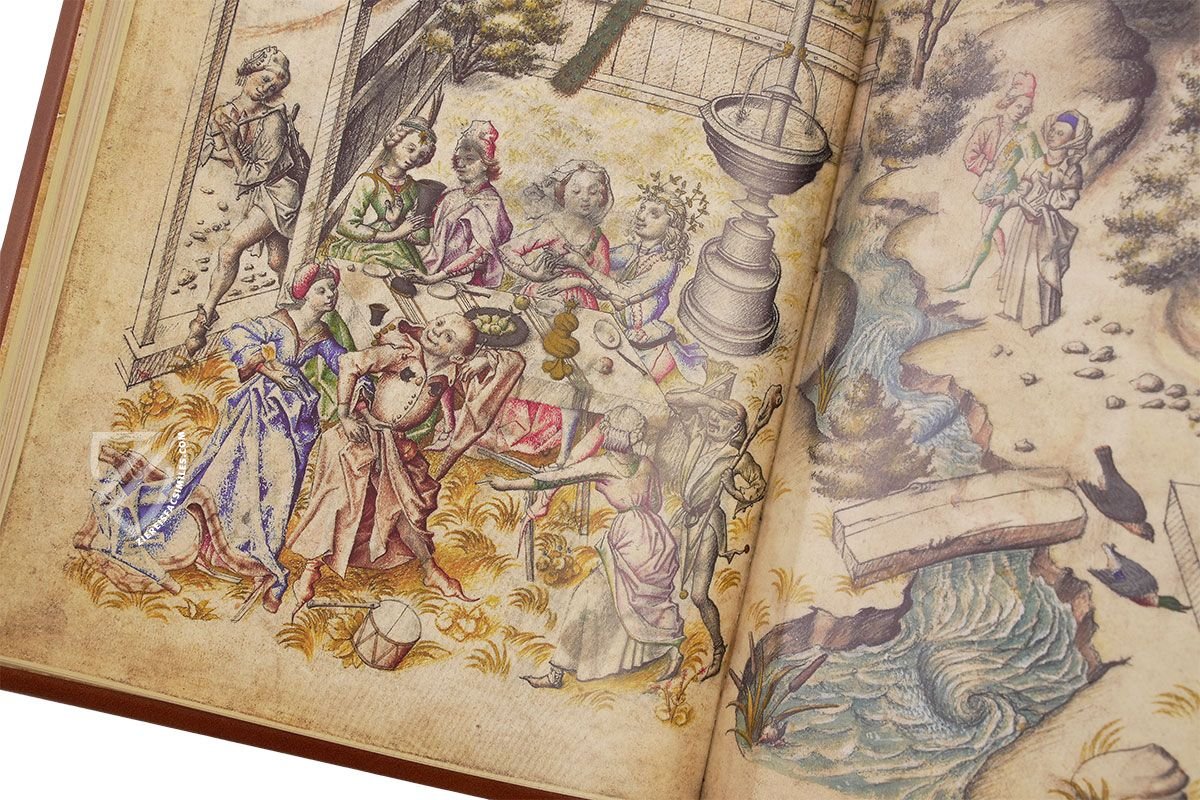
Medieval Housebook of Wolfegg Castle
Mining Panorama
Embedded in a rocky but green landscape, an overview of medieval mining is given here from mining in tunnels carved into the mountain to crushing and transporting the ore away in wheelbarrows. Winding paths lead to the destinations of the processed material – a majestic castle and a fortified town next to an idyllic body of water. Meanwhile, a heated scuffle breaks out on the forecourt of the large administrative building in the lower left corner.
The couple on the lower right remains completely unimpressed by this as the knight of the Order of the Pitcher seems to be explaining the importance of mining for the life of the nobility to his beloved. This magnificent miniature fittingly introduces the chapter on mining, metallurgy, and coinage, which must have been extremely relevant for the blue-blooded owner of the book.
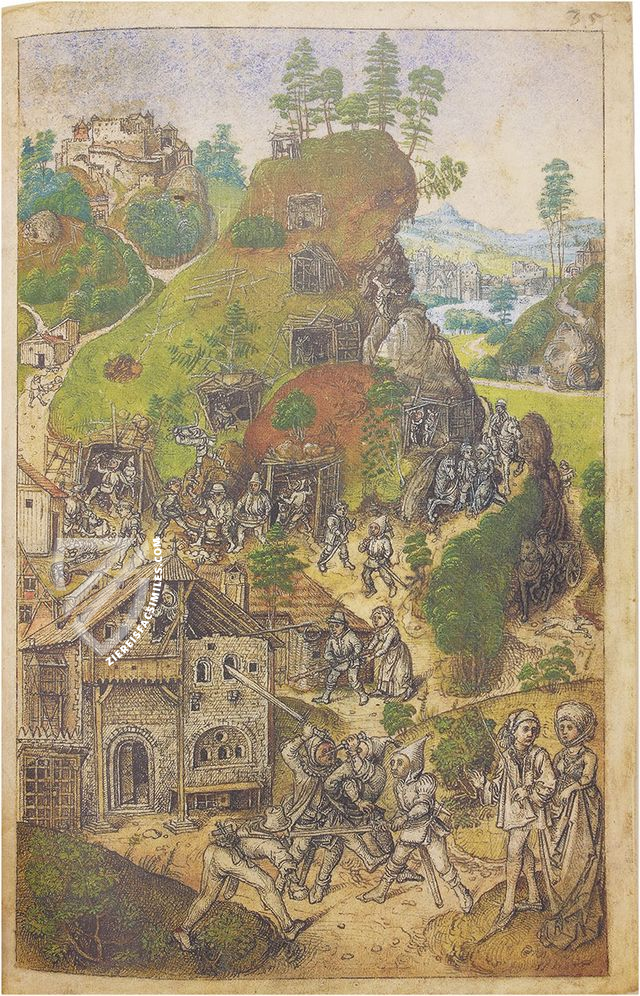
#1 Das Mittelalterliche Hausbuch
Languages: English, German
(1,000€ - 3,000€)
- Treatises / Secular Books
- Apocalypses / Beatus
- Astronomy / Astrology
- Bestiaries
- Bibles / Gospels
- Chronicles / History / Law
- Geography / Maps
- Saints' Lives
- Islam / Oriental
- Judaism / Hebrew
- Single Leaf Collections
- Leonardo da Vinci
- Literature / Poetry
- Liturgical Manuscripts
- Medicine / Botany / Alchemy
- Music
- Mythology / Prophecies
- Psalters
- Other Religious Books
- Games / Hunting
- Private Devotion Books
- Other Genres
- Afghanistan
- Armenia
- Austria
- Belgium
- Belize
- Bosnia and Herzegovina
- China
- Colombia
- Costa Rica
- Croatia
- Cyprus
- Czech Republic
- Denmark
- Egypt
- El Salvador
- Ethiopia
- France
- Germany
- Greece
- Guatemala
- Honduras
- Hungary
- India
- Iran
- Iraq
- Israel
- Italy
- Japan
- Jordan
- Kazakhstan
- Kyrgyzstan
- Lebanon
- Liechtenstein
- Luxembourg
- Mexico
- Morocco
- Netherlands
- Palestine
- Panama
- Peru
- Poland
- Portugal
- Romania
- Russia
- Serbia
- Spain
- Sri Lanka
- Sweden
- Switzerland
- Syria
- Tajikistan
- Turkey
- Turkmenistan
- Ukraine
- United Kingdom
- United States
- Uzbekistan
- Vatican City
- A. Oosthoek, van Holkema & Warendorf
- Aboca Museum
- Ajuntament de Valencia
- Akademie Verlag
- Akademische Druck- u. Verlagsanstalt (ADEVA)
- Aldo Ausilio Editore - Bottega d’Erasmo
- Alecto Historical Editions
- Alkuin Verlag
- Almqvist & Wiksell
- Amilcare Pizzi
- Andreas & Andreas Verlagsbuchhandlung
- Archa 90
- Archiv Verlag
- Archivi Edizioni
- Arnold Verlag
- ARS
- Ars Magna
- ArtCodex
- AyN Ediciones
- Azimuth Editions
- Badenia Verlag
- Bärenreiter-Verlag
- Belser Verlag
- Belser Verlag / WK Wertkontor
- Benziger Verlag
- Bernardinum Wydawnictwo
- BiblioGemma
- Biblioteca Apostolica Vaticana (Vaticanstadt, Vaticanstadt)
- Bibliotheca Palatina Faksimile Verlag
- Bibliotheca Rara
- Boydell & Brewer
- Bramante Edizioni
- Bredius Genootschap
- Brepols Publishers
- British Library
- C. Weckesser
- Caixa Catalunya
- Canesi
- CAPSA, Ars Scriptoria
- Caratzas Brothers, Publishers
- Carus Verlag
- Casamassima Libri
- Centrum Cartographie Verlag GmbH
- Chavane Verlag
- Christian Brandstätter Verlag
- Circulo Cientifico
- Club Bibliófilo Versol
- Club du Livre
- CM Editores
- Collegium Graphicum
- Collezione Apocrifa Da Vinci
- Comissão Nacional para as Comemorações dos Descobrimentos Portugueses
- Coron Verlag
- Corvina
- CTHS
- D. S. Brewer
- Damon
- De Agostini/UTET
- De Nederlandsche Boekhandel
- De Schutter
- Deuschle & Stemmle
- Deutscher Verlag für Kunstwissenschaft
- DIAMM
- Droz
- E. Schreiber Graphische Kunstanstalten
- Ediciones Boreal
- Ediciones Grial
- Ediclube
- Edições Inapa
- Edilan
- Editalia
- Edition Deuschle
- Edition Georg Popp
- Edition Leipzig
- Edition Libri Illustri
- Editiones Reales Sitios S. L.
- Éditions de l'Oiseau Lyre
- Editions Medicina Rara
- Editorial Casariego
- Editorial Mintzoa
- Editrice Antenore
- Editrice Velar
- Edizioni Edison
- Egeria, S.L.
- Eikon Editores
- Electa
- Emery Walker Limited
- Enciclopèdia Catalana
- Eos-Verlag
- Ephesus Publishing
- Ernst Battenberg
- Eugrammia Press
- Extraordinary Editions
- Fackelverlag
- Facsimila Art & Edition
- Facsimile Editions Ltd.
- Facsimilia Art & Edition Ebert KG
- Faksimile Verlag
- Feuermann Verlag
- Folger Shakespeare Library
- Franco Cosimo Panini Editore
- Friedrich Wittig Verlag
- Fundación Hullera Vasco-Leonesa
- G. Braziller
- Gabriele Mazzotta Editore
- Gebr. Mann Verlag
- Gesellschaft für graphische Industrie
- Getty Research Institute
- Giovanni Domenico de Rossi
- Giunti Editore
- Graffiti
- Grafica European Center of Fine Arts
- Guido Pressler
- Guillermo Blazquez
- Gustav Kiepenheuer
- H. N. Abrams
- Harrassowitz
- Harvard University Press
- Helikon
- Hendrickson Publishers
- Henning Oppermann
- Herder Verlag
- Hes & De Graaf Publishers
- Hoepli
- Holbein-Verlag
- Houghton Library
- Hugo Schmidt Verlag
- Idion Verlag
- Il Bulino, edizioni d'arte
- ILte
- Imago
- Insel Verlag
- Insel-Verlag Anton Kippenberger
- Instituto de Estudios Altoaragoneses
- Instituto Nacional de Antropología e Historia
- Introligatornia Budnik Jerzy
- Istituto dell'Enciclopedia Italiana - Treccani
- Istituto Ellenico di Studi Bizantini e Postbizantini
- Istituto Geografico De Agostini
- Istituto Poligrafico e Zecca dello Stato
- Italarte Art Establishments
- Jan Thorbecke Verlag
- Johnson Reprint Corporation
- Josef Stocker
- Josef Stocker-Schmid
- Jugoslavija
- Karl W. Hiersemann
- Kasper Straube
- Kaydeda Ediciones
- Kindler Verlag / Coron Verlag
- Kodansha International Ltd.
- Konrad Kölbl Verlag
- Kurt Wolff Verlag
- La Liberia dello Stato
- La Linea Editrice
- La Meta Editore
- Lambert Schneider
- Landeskreditbank Baden-Württemberg
- Leo S. Olschki
- Les Incunables
- Liber Artis
- Library of Congress
- Libreria Musicale Italiana
- Lichtdruck
- Lito Immagine Editore
- Lumen Artis
- Lund Humphries
- M. Moleiro Editor
- Maison des Sciences de l'homme et de la société de Poitiers
- Manuscriptum
- Martinus Nijhoff
- Maruzen-Yushodo Co. Ltd.
- MASA
- Massada Publishers
- McGraw-Hill
- Metropolitan Museum of Art
- Militos
- Millennium Liber
- Müller & Schindler
- Nahar - Stavit
- Nahar and Steimatzky
- National Library of Wales
- Neri Pozza
- Nova Charta
- Oceanum Verlag
- Odeon
- Orbis Mediaevalis
- Orbis Pictus
- Österreichische Staatsdruckerei
- Oxford University Press
- Pageant Books
- Parzellers Buchverlag
- Patrimonio Ediciones
- Pattloch Verlag
- PIAF
- Pieper Verlag
- Plon-Nourrit et cie
- Poligrafiche Bolis
- Presses Universitaires de Strasbourg
- Prestel Verlag
- Princeton University Press
- Prisma Verlag
- Priuli & Verlucca, editori
- Pro Sport Verlag
- Propyläen Verlag
- Pytheas Books
- Quaternio Verlag Luzern
- Reales Sitios
- Recht-Verlag
- Reichert Verlag
- Reichsdruckerei
- Reprint Verlag
- Riehn & Reusch
- Roberto Vattori Editore
- Rosenkilde and Bagger
- Roxburghe Club
- Salerno Editrice
- Saltellus Press
- Sandoz
- Sarajevo Svjetlost
- Schöck ArtPrint Kft.
- Schulsinger Brothers
- Scolar Press
- Scrinium
- Scripta Maneant
- Scriptorium
- Shazar
- Siloé, arte y bibliofilia
- SISMEL - Edizioni del Galluzzo
- Sociedad Mexicana de Antropología
- Société des Bibliophiles & Iconophiles de Belgique
- Soncin Publishing
- Sorli Ediciones
- Stainer and Bell
- Studer
- Styria Verlag
- Sumptibus Pragopress
- Szegedi Tudomànyegyetem
- Taberna Libraria
- Tarshish Books
- Taschen
- Tempus Libri
- Testimonio Compañía Editorial
- Thames and Hudson
- The Clear Vue Publishing Partnership Limited
- The Facsimile Codex
- The Folio Society
- The Marquess of Normanby
- The Richard III and Yorkist History Trust
- Tip.Le.Co
- TouchArt
- TREC Publishing House
- TRI Publishing Co.
- Trident Editore
- Tuliba Collection
- Typis Regiae Officinae Polygraphicae
- Union Verlag Berlin
- Universidad de Granada
- University of California Press
- University of Chicago Press
- Urs Graf
- Vallecchi
- Van Wijnen
- VCH, Acta Humaniora
- VDI Verlag
- VEB Deutscher Verlag für Musik
- Verlag Anton Pustet / Andreas Verlag
- Verlag Bibliophile Drucke Josef Stocker
- Verlag der Münchner Drucke
- Verlag für Regionalgeschichte
- Verlag Styria
- Vicent Garcia Editores
- W. Turnowski Ltd.
- W. Turnowsky
- Waanders Printers
- Wiener Mechitharisten-Congregation (Wien, Österreich)
- Wissenschaftliche Buchgesellschaft
- Wissenschaftliche Verlagsgesellschaft
- Wydawnictwo Dolnoslaskie
- Xuntanza Editorial
- Zakład Narodowy
- Zollikofer AG

